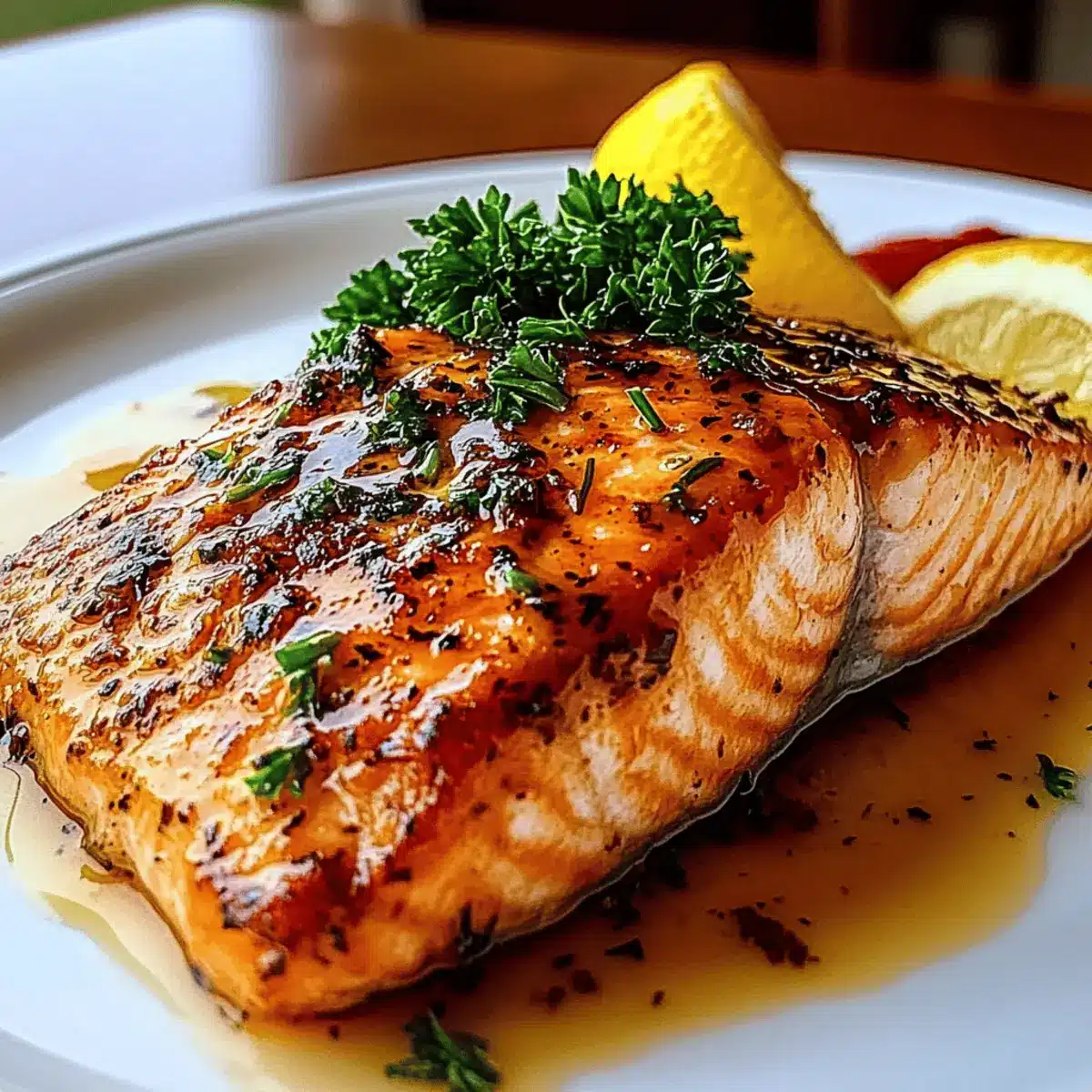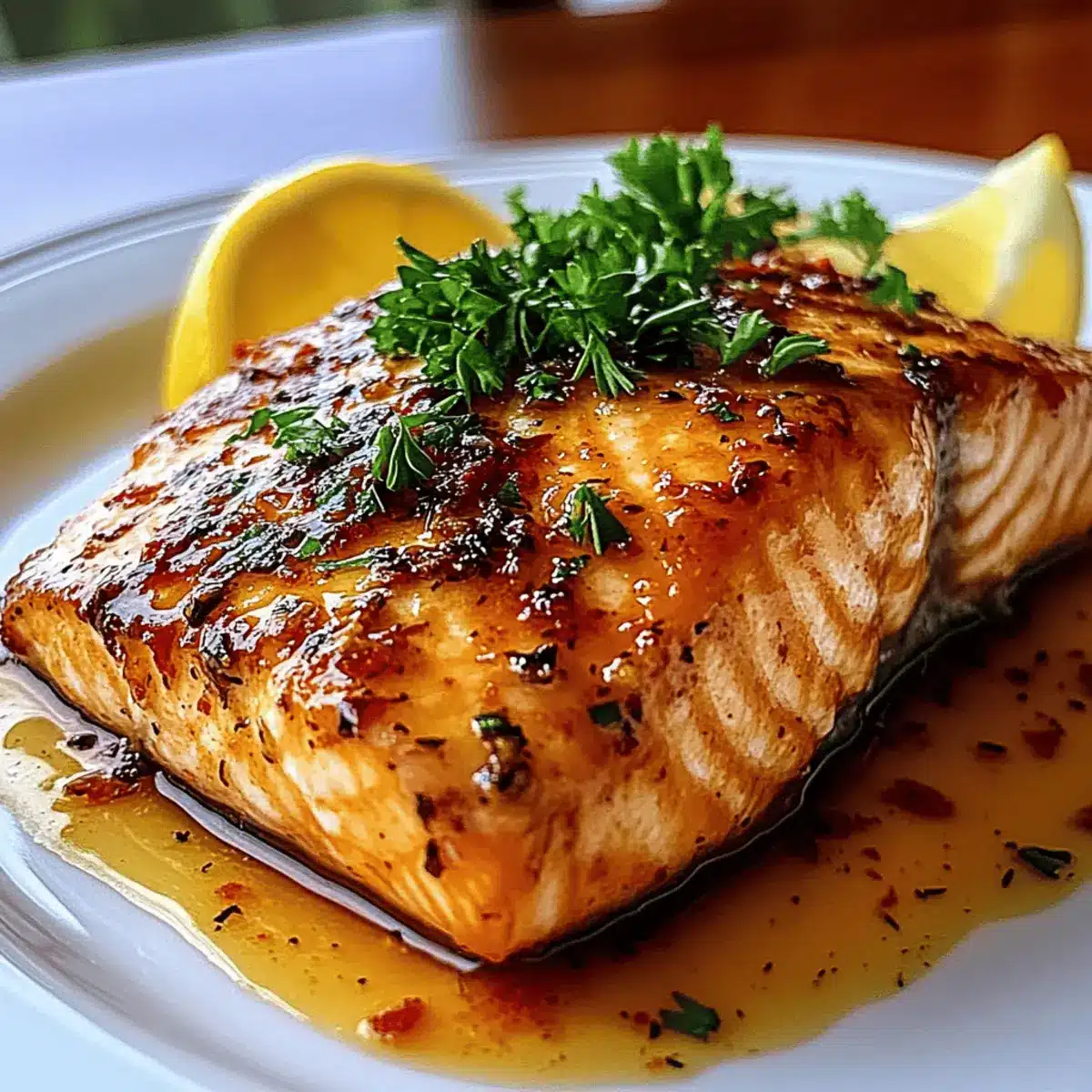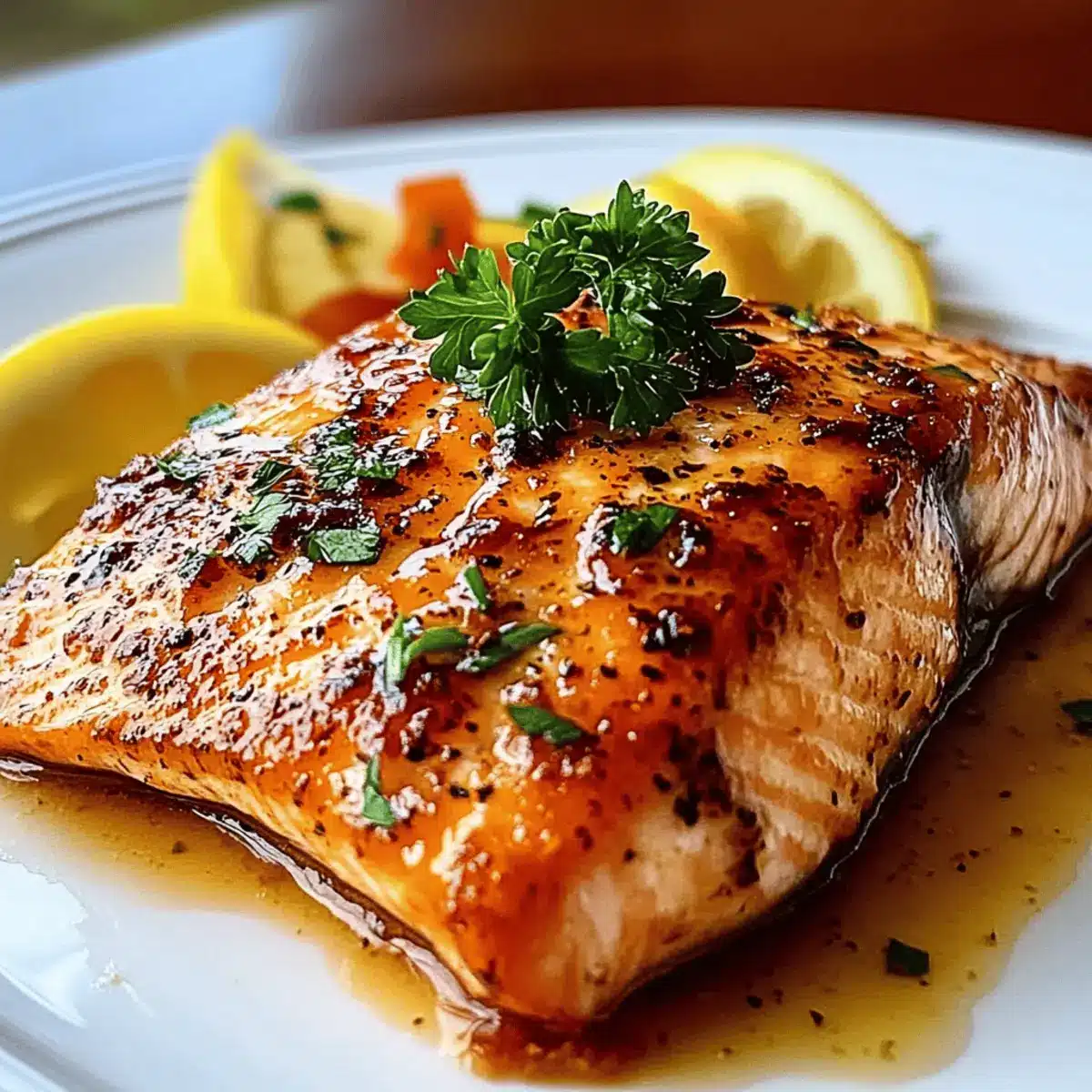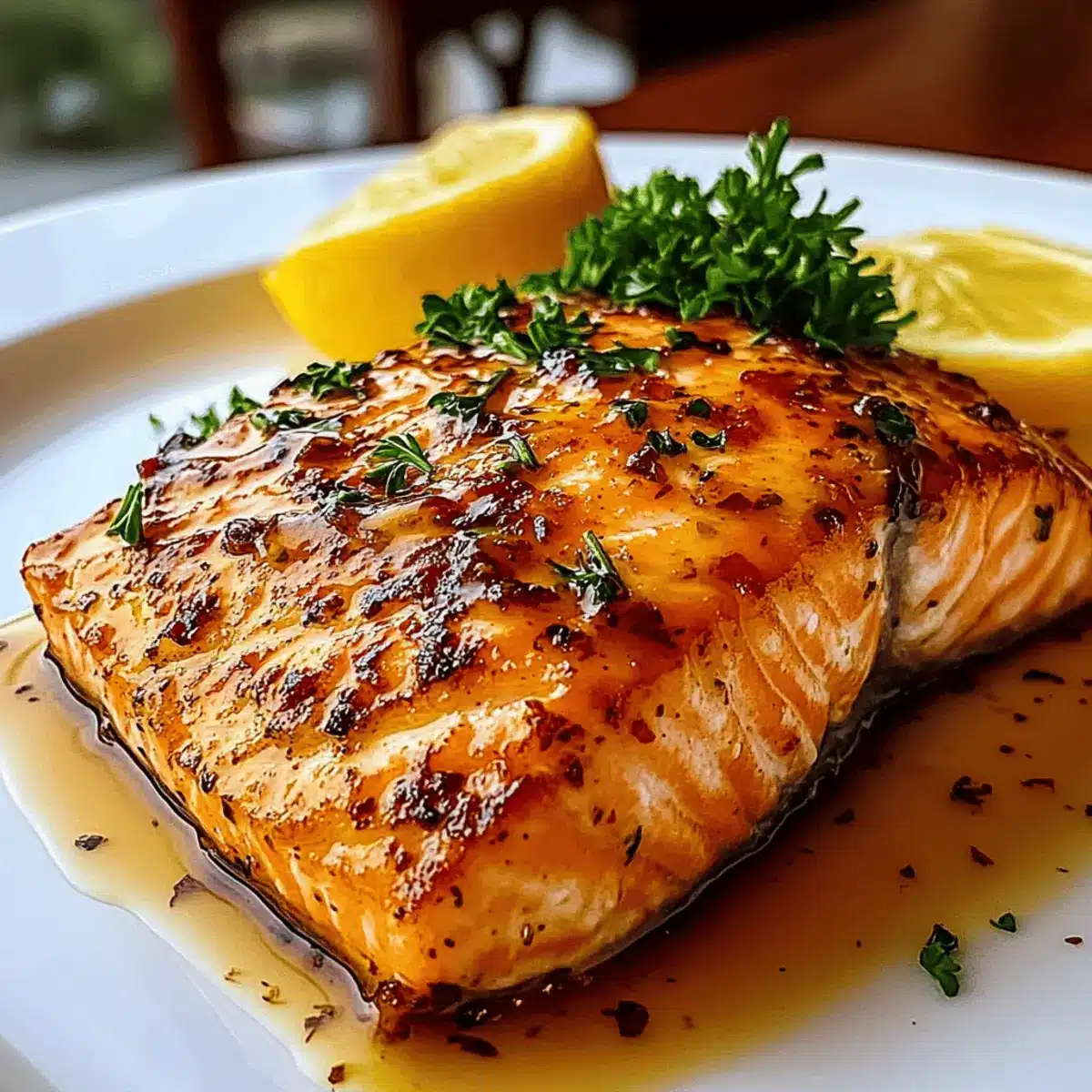As I stood by the grill the other evening, the tantalizing aroma of sweet and smoky goodness wafted through the air, instantly transporting me to my favorite Texas Roadhouse. That’s when it hit me: I needed to recreate their famous Texas Roadhouse Salmon right in my kitchen! With its juicy, flaky texture and that irresistible glaze, this dish is not only a crowd-pleaser but also simple to prepare, making it perfect for both busy weeknights and special gatherings. You’ll be amazed at how this delicious salmon, coated in a beautifully caramelized glaze of brown sugar and smoked paprika, can bring restaurant-quality dining right to your dining table. Are you ready to make some culinary magic happen? Let’s dive in!
Why is This Salmon Recipe So Special?
Unforgettable flavor: This Texas Roadhouse Salmon boasts a sweet and smoky glaze that elevates the dish to new heights, perfect for those who crave vibrant taste.
Easy preparation: With minimal ingredients and straightforward steps, it’s accessible for home cooks of all skill levels.
Versatile pairing: Whether you enjoy it with creamy mashed potatoes or a fresh garden salad, it seamlessly fits into any meal.
Crowd-pleaser: This dish is sure to impress guests, making it ideal for gatherings or a cozy dinner at home.
If you’re interested in more salmon delights, be sure to check out our Cajun Grilled Salmon or try a comforting Salmon Tortellini Discover for a delightful twist!
Texas Roadhouse Salmon Ingredients
• Dive into the flavors of Texas Roadhouse with these simple ingredients!
For the Salmon
- Salmon Fillets – Opt for fresh Atlantic or wild-caught for the best flavor and texture.
- Olive Oil – Helps the glaze adhere and promotes a crispy exterior.
For the Glaze
- Brown Sugar – Adds a beautifully caramelized sweetness that complements the savory notes of the fish.
- Smoked Paprika – Infuses a deep smoky flavor reminiscent of Texas Roadhouse salmon.
- Garlic Powder – Enhances the dish with a subtle garlic aroma.
- Lemon Juice – Brightens the dish and balances the glaze’s richness.
- Dijon Mustard – Provides tang and depth to the sweet glaze.
- Soy Sauce – Offers umami flavor; substitute with tamari for a gluten-free option.
Optional Garnish
- Parsley – Adds a pop of freshness and color just before serving.
Feel free to embark on your culinary adventure with this Texas Roadhouse Salmon recipe, and let the sweet and smoky goodness bring your kitchen to life!
Step‑by‑Step Instructions for Texas Roadhouse Salmon
Step 1: Preheat the Oven or Grill
Begin by preheating your oven to 400°F. If you prefer grilling, prepare your grill for medium-high heat. This step is key to achieving that perfect, flaky texture for your Texas Roadhouse Salmon. Make sure the cooking surface is hot, ensuring that the fish cooks evenly for a deliciously caramelized crust.
Step 2: Prepare the Salmon Fillets
While the oven is heating, take your fresh salmon fillets and pat them dry with paper towels. This helps the olive oil adhere better. Next, brush the fillets generously with olive oil on all sides to promote browning and enhance flavor. This simple action sets the stage for a beautiful glaze to cling to the salmon.
Step 3: Make the Sweet and Smoky Glaze
In a medium bowl, whisk together brown sugar, smoked paprika, garlic powder, lemon juice, Dijon mustard, and soy sauce until smooth. This mixture will create the signature sweet and smoky glaze that makes the Texas Roadhouse Salmon so irresistible. Give it a good stir until all the ingredients are well combined and the glaze is uniform in color and texture.
Step 4: Marinate the Salmon
Once your glaze is ready, spoon or brush it generously over the salmon fillets, ensuring they are evenly coated. Let the fillets marinate for at least 10-15 minutes at room temperature. This allows the flavors to penetrate the salmon, making each bite intensely flavorful when cooked.
Step 5: Place the Salmon for Cooking
After marinating, place the salmon fillets on a lined baking sheet if baking or directly on the preheated grill grates if grilling. Make sure to position the fillets skin-side down for optimal cooking. The glaze will begin to caramelize beautifully as the salmon cooks, adding to its mouthwatering appeal.
Step 6: Cook the Salmon
For baking, slide the prepared salmon into the oven and bake for 12-15 minutes. If grilling, cook the fillets for 6-7 minutes per side. You’ll know your Texas Roadhouse Salmon is done when it flakes easily with a fork and has a beautifully caramelized crust. Keep an eye on the time to avoid overcooking!
Step 7: Rest and Garnish the Salmon
Once cooked, remove the salmon from the oven or grill and let it rest for a few minutes on a cutting board. This allows the juices to redistribute, keeping the fish moist. Just before serving, optionally sprinkle with fresh parsley for a burst of flavor and color, and pair it with lemon wedges for a refreshing touch.
Expert Tips for Texas Roadhouse Salmon
-
Use skin-on fillets: Provides better moisture retention and easier handling during cooking, keeping your Texas Roadhouse Salmon juicier.
-
Watch the cooking time: To prevent overcooking, monitor closely; thicker cuts are ideal as they hold up better on the grill.
-
Marinating is key: Allowing the salmon to marinate for 10-15 minutes enhances the flavor absorption of the sweet and smoky glaze.
-
Avoid sticking: If grilling, ensure your grill grates are well-oiled to prevent the salmon from sticking when flipping.
-
Serve fresh: For the best experience, enjoy the salmon immediately after cooking; it tastes best when it’s warm and freshly plated.
Make Ahead Options
These Texas Roadhouse Salmon fillets are perfect for meal prep enthusiasts! You can prepare the sweet and smoky glaze up to 2 days in advance and store it in the refrigerator, making it easy to whip up this flavorful dish on busy weeknights. Simply coat your salmon fillets with olive oil and let them marinate for up to 24 hours in the fridge before cooking. This allows the flavors to develop and ensures that the salmon stays juicy and delicious. When you’re ready to serve, bake or grill the marinated salmon as per the original instructions, and you’ll have a restaurant-quality meal ready in no time!
Variations & Substitutions for Texas Roadhouse Salmon
Feel free to get creative and make this Texas Roadhouse Salmon your own with these delicious tweaks!
- Gluten-Free: Substitute soy sauce with tamari for a gluten-free glaze without sacrificing flavor. Your guests will never know the difference!
- Healthier Sweetener: Opt for coconut sugar instead of brown sugar for a lower glycemic index alternative while still delivering sweetness to the glaze.
- Different Fish: Experiment with trout or arctic char as a delicious alternative to salmon, each providing unique flavor and texture experiences.
- Bold Spices: Add crushed red pepper flakes to the glaze for an extra spicy kick that elevates this meal and awakens your taste buds.
- Citrus Twist: Replace lemon juice with lime juice or orange juice for a refreshing twist that adds a zesty zing to the glaze.
- Herb Variation: Instead of parsley, try fresh cilantro or dill for a different herbal finish; they bring delightful new dimensions to the dish.
- Smoky Flavor Boost: Incorporate liquid smoke into the glaze for an even smokier flavor that replicates the outdoor grilling experience!
- Creative Sides: Pair with creamy Salmon Tortellini Discover or Cajun Grilled Salmon for a unique salmon experience that’ll impress dinner guests.
With these variations, you can easily tailor your Texas Roadhouse Salmon to meet your taste preferences and dietary needs while keeping dinner exciting!
How to Store and Freeze Texas Roadhouse Salmon
Fridge: Allow cooked Texas Roadhouse Salmon to cool completely before placing it in an airtight container. Store in the refrigerator for up to 3 days, ensuring it’s well-wrapped to retain moisture.
Freezer: For longer storage, wrap individual portions of cooked salmon tightly in plastic wrap, then in aluminum foil. Freeze for up to 3 months. Thaw overnight in the fridge before reheating.
Reheating: To reheat, place salmon in a preheated oven at 350°F for 10-15 minutes or until warmed through. Alternatively, microwave for 1-2 minutes on low, covering with a damp paper towel to maintain moisture.
Make-Ahead Tip: Prepare the sweet and smoky glaze up to 2 days in advance and refrigerate, then cook the salmon fresh for the best flavor and texture.
What to Serve with Texas Roadhouse Salmon
Imagine a beautiful dinner spread where tender, flaky salmon meets deliciously complementary sides, creating a meal that tantalizes the senses.
- Creamy Mashed Potatoes: These velvety potatoes are a classic pairing that balances the smoky glaze and adds extra comfort to your meal.
- Buttered Green Beans: Crisp-tender green beans enhance the dish with a fresh texture and lightness, making your plate visually tempting.
- Garden Salad: A vibrant salad filled with mixed greens, cherry tomatoes, and a light vinaigrette brings refreshing brightness to each bite of salmon.
- Couscous with Herbs: Fluffy, herb-infused couscous offers a delightful nuttiness that pairs beautifully with the sweet and smoky salmon flavors.
- Roasted Asparagus: The earthy taste of roasted asparagus adds a crunchy contrast that compliments the salmon’s rich texture effectively.
- Quinoa Pilaf: Nutty quinoa mixed with aromatic herbs and spices provides a healthy, protein-packed side that wonderfully balances the meal.
- Lemon Dill Rice: Fluffy rice flavored with fresh lemon and dill adds a zesty twist, enhancing the salmon’s delicious glaze.
- Fruit Salsa: A refreshing fruit salsa made with mango or pineapple gives an unexpected sweet-and-sour element, elevating the dining experience.
- Chilled White Wine: A crisp, chilled white wine, such as Sauvignon Blanc, perfectly complements the rich flavors of the salmon, making it a delightful dining addition.
- Chocolate Mousse: To end on a sweet note, a light and airy chocolate mousse offers a rich finale that lingers beautifully after the savory main course.
Texas Roadhouse Salmon Recipe FAQs
What type of salmon is best for this recipe?
Absolutely! For the best flavor and texture, I recommend using fresh Atlantic salmon or wild-caught salmon fillets. Look for pieces that are bright in color with minimal dark spots; they should feel firm to the touch.
How should I store leftover salmon?
Very! Allow the cooked Texas Roadhouse Salmon to cool completely before transferring it to an airtight container. It can be stored in the refrigerator for up to 3 days. To maintain moisture, ensure it’s wrapped well or sealed tightly.
Can I freeze cooked salmon?
Yes, you can! To freeze cooked salmon, wrap individual portions tightly in plastic wrap, then in aluminum foil. This will help prevent freezer burn. You can freeze it for up to 3 months. When you’re ready to enjoy it, thaw overnight in the fridge before reheating.
How do I reheat cooked salmon without drying it out?
Excellent question! To reheat your Texas Roadhouse Salmon, place it in a preheated oven at 350°F for about 10-15 minutes or until warmed through. Alternatively, you can use a microwave; cover it with a damp paper towel and heat it on low for 1-2 minutes, checking to ensure it doesn’t dry out.
Can this recipe cater to gluten-free diets?
Absolutely! You can easily make this Texas Roadhouse Salmon gluten-free by substituting regular soy sauce with tamari. This swap will not only keep your dish gluten-free but also retains the delicious umami flavor in the glaze.
What should I do if my salmon isn’t caramelizing?
No worries! If your salmon isn’t caramelizing, try checking your oven temperature to ensure it’s preheated correctly. You can also brush a little more glaze on during the last few minutes of cooking to help build that beautiful, caramelized crust. If grilling, make sure your grill is hot enough before placing the salmon on it!

Texas Roadhouse Salmon: Sweet, Smoky, and Simply Delicious
Ingredients
Equipment
Method
- Preheat your oven to 400°F or prepare your grill for medium-high heat.
- Pat the salmon fillets dry with paper towels and brush them with olive oil.
- In a medium bowl, whisk together brown sugar, smoked paprika, garlic powder, lemon juice, Dijon mustard, and soy sauce until smooth.
- Spoon or brush the glaze generously over the salmon fillets and let them marinate for 10-15 minutes.
- Place the salmon fillets on a lined baking sheet or directly on the preheated grill grates, skin-side down.
- Bake for 12-15 minutes or grill for 6-7 minutes per side until the salmon flakes easily with a fork.
- Remove the salmon from the oven or grill, let it rest for a few minutes, and sprinkle with fresh parsley before serving.




